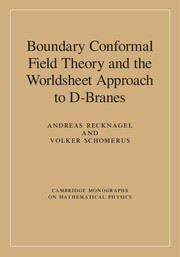Book contents
- Frontmatter
- Dedication
- Contents
- Introduction
- 1 Free field theory with boundaries
- 2 Superstrings and branes
- 3 Conformal field theory on the plane
- 4 Boundary conformal field theory
- 5 Perturbations of boundary conformal field theories
- 6 The Wess–Zumino–Witten model on SU(2)
- 7 Gepner model boundary states and Calabi–Yau branes
- Appendix
- References
- Index
3 - Conformal field theory on the plane
Published online by Cambridge University Press: 05 November 2013
- Frontmatter
- Dedication
- Contents
- Introduction
- 1 Free field theory with boundaries
- 2 Superstrings and branes
- 3 Conformal field theory on the plane
- 4 Boundary conformal field theory
- 5 Perturbations of boundary conformal field theories
- 6 The Wess–Zumino–Witten model on SU(2)
- 7 Gepner model boundary states and Calabi–Yau branes
- Appendix
- References
- Index
Summary
In this chapter, we give a brief overview of conformal field theory (CFT) on the plane, in an attempt to make the whole text more or less self-contained as far as worldsheet aspects are concerned. Some of the concepts to be discussed have been used in Chapter 1 already, but they will be put in a more general, model-independent context in the following. Many of the notions and tools to be reviewed will re-appear in the subsequent investigation of boundary CFT.
There are various alternative formulations of CFT, but our exposition will mainly follow the spirit of Belavin, Polyakov and Zamolodchikov [45]. One reason is that, up to now, no other framework has been adapted to boundary theories with equal success. However, each formulation has its virtues, and a great deal of the fascination of CFT comes from the interplay of very different mathematical structures.
The functional integral framework has the advantage that theories on surfaces of higher genus can be treated essentially on the same footing as CFTs on the complex plane. In addition, many abstract results find natural geometrical interpretations. We refer to [166, 223–225, 227] and the literature quoted there for more details. The disadvantage of functional integrals is that, by definition, we have to start from a description in terms of a classical action.
- Type
- Chapter
- Information
- Publisher: Cambridge University PressPrint publication year: 2013



